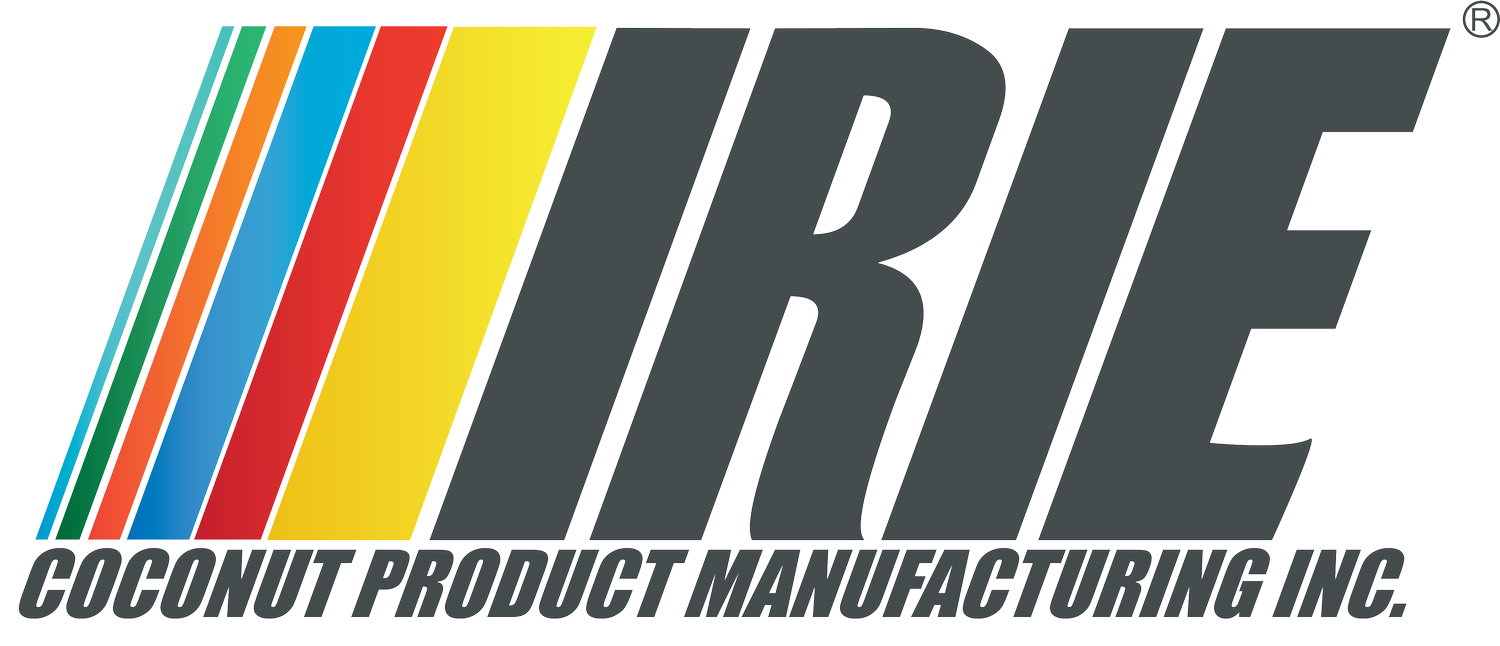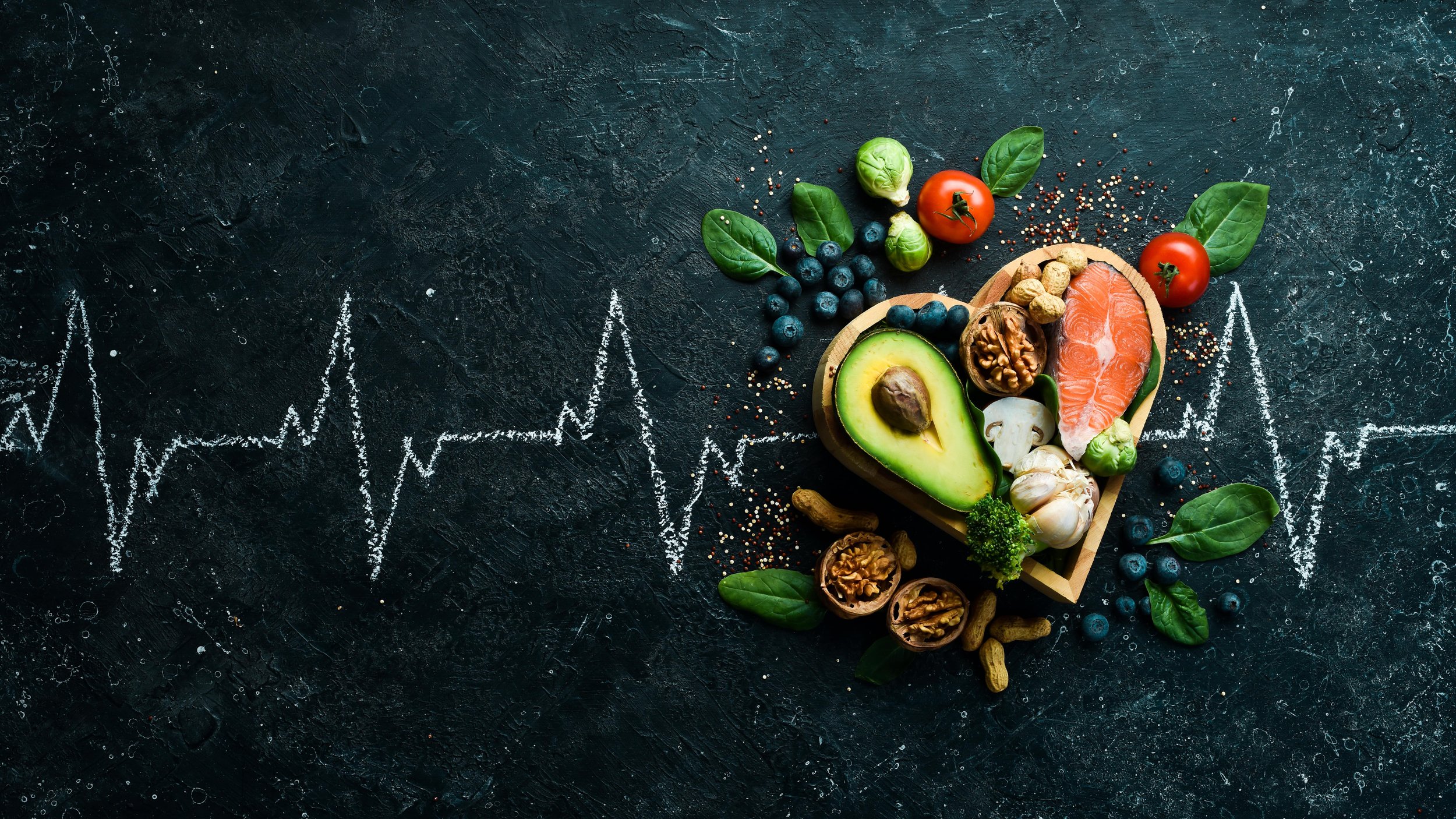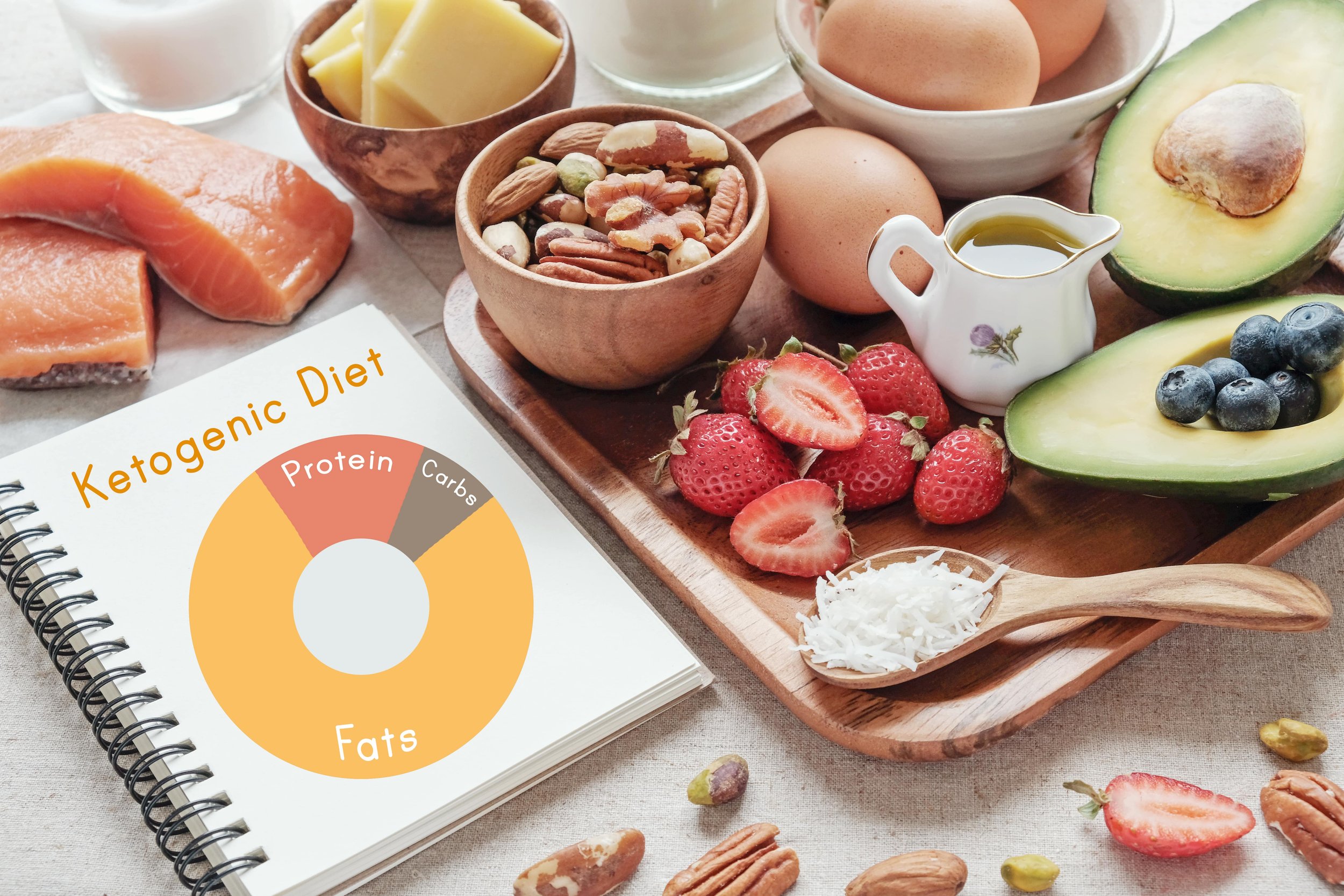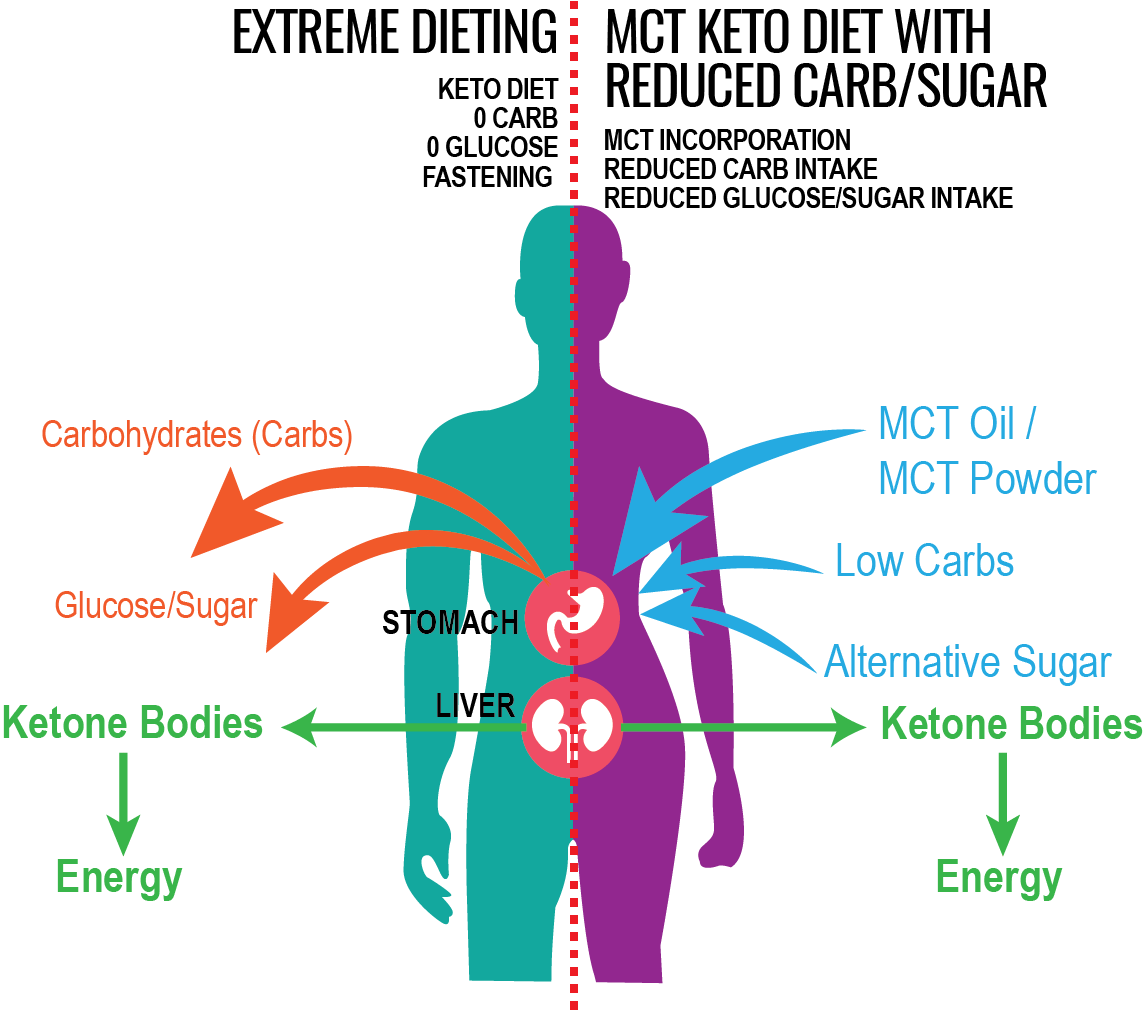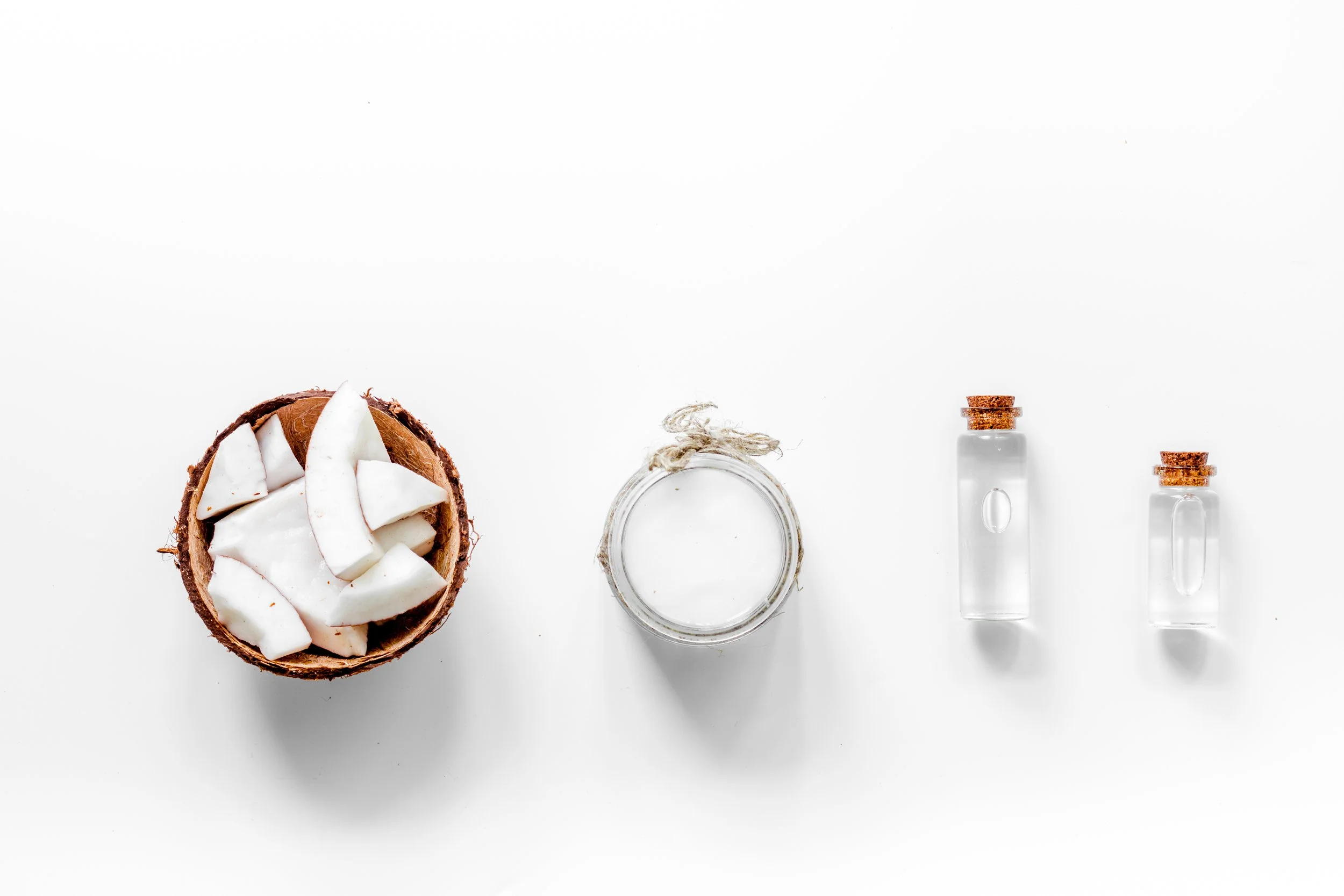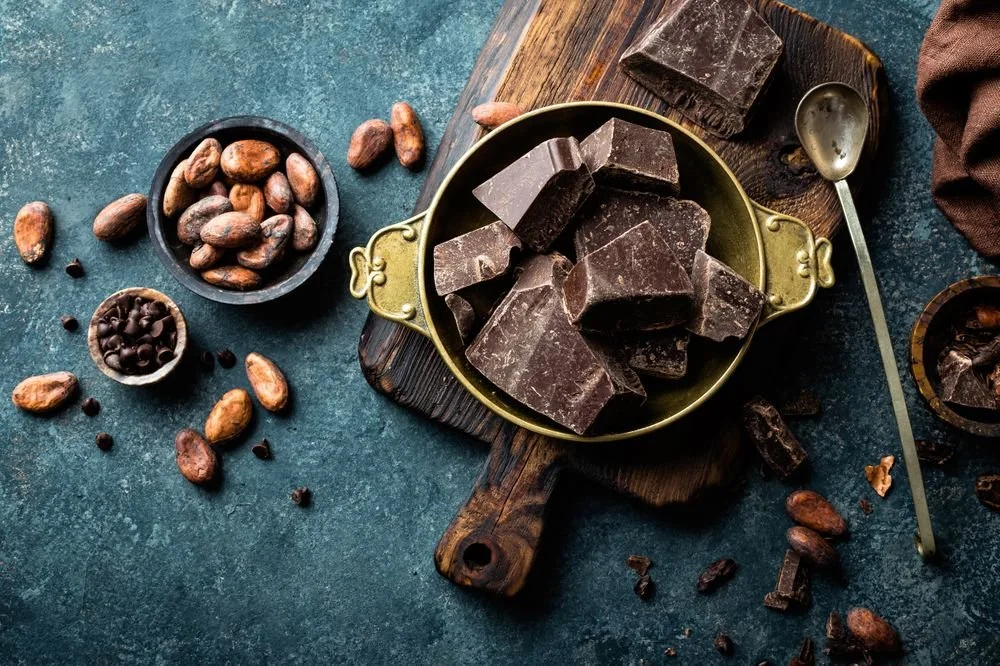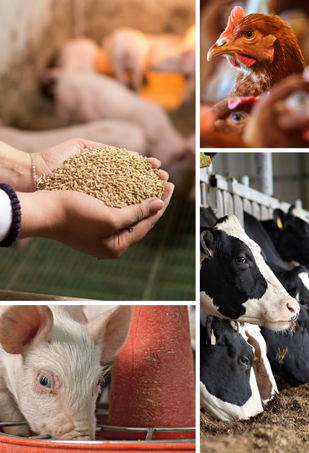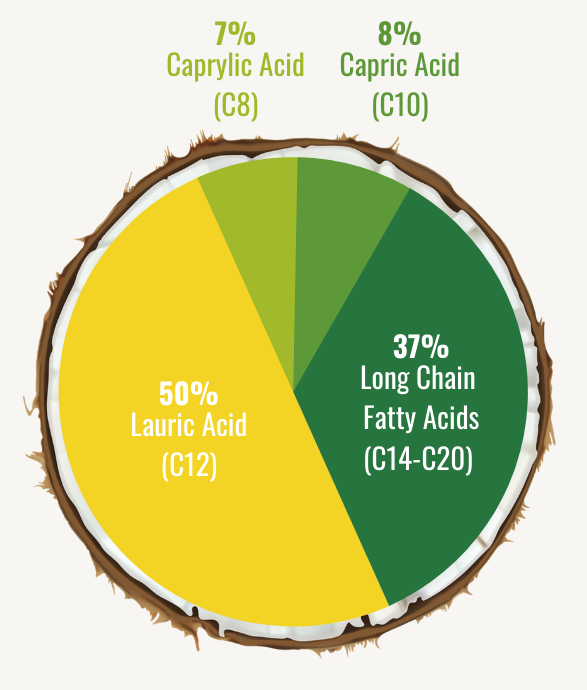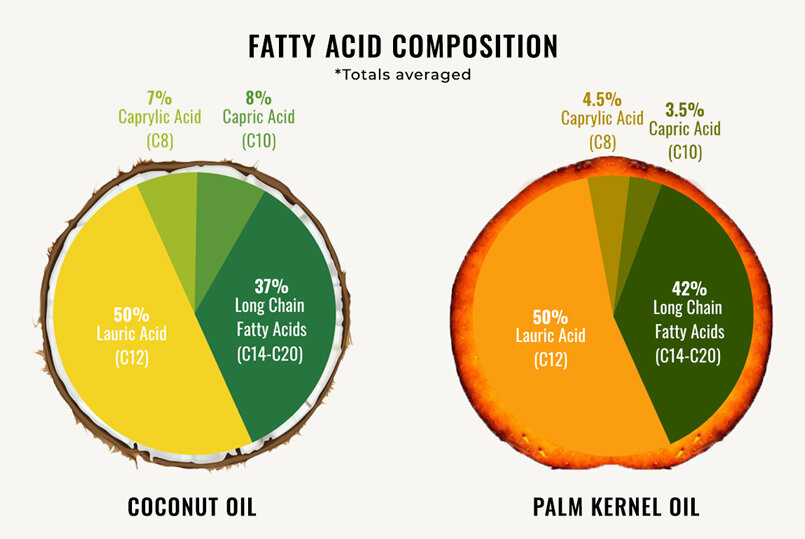LEARNING CENTER
KETONES & MCT: The long hard truth
Ketones are a type of chemical that our liver produces when it breaks down fat.
Our bodies naturally use ketones for energy typically during fasting, long periods of exercise, or when you don’t have as many carbohydrates. Normally, the cells in our bodies use glucose (sugar) for energy. You get glucose from eating carbohydrates or sugar-based foods. If our cells don’t get enough glucose and/or carbs, our bodies will break down fat for energy instead.
This process produces ketones, and our bodies go into a state that’s called “Ketosis”.
Does this mean the more ketones I generate, the more I lose weight and generate my own natural energy??
- ANSWER: NO. Ketosis is like an Automatic emergency light. Comes on during emergencies and does not constantly stay on.
- Constantly having your Ketones at a high % everyday in our bodies is dangerous.
There 3 types of energy producing Ketones we produce;
Acetone - The simplest and smallest Ketone
Acetoacetic Acid – Simple beta keto acid that is unstable and weak.
Hydroxybutyric Acid (3HB) – Strong acids and the most abundant in mammals. 3HB is the major ketone body that is distributed in the human brain and primary energy source when glucose is absent.
An unusually HIGH % of Ketones when managed incorrectly is bad. With the limitation/removal of Sugar/Glucose/Carbs for people with Diabetes or sensitive to a lack of sugar this can lead to another type of diabetes called Diabetic Ketoacidosis (KDA) – a life threatening medical emergency.
Too many ketones can make your blood acidic and toxic. So our bodies naturally exit excess Ketones through our urine.
As is, individuals are able to naturally achieve ketosis by one or a combination of the following;
Intermittent Fasting
Bring on the fat; The Keto Diet allows many people to eat the types of high fat foods that we normally enjoy like; Red meats, fatty fish, cheese and butter, while still losing weight (or so we think).
Cut out the Sugars. No more ice cream, no breads, or pastas.
The above methods have shown natural occurrences and increase in ketones however they do pose problems with consistency in long term application such as:
Difficult to sustain; Due to the stringent food restrictions, many find the keto diet hard to stick to.
Fasting (monthly) is a difficult task be consistent. Ketone production is not consistent in this state and can lead to further problems if Ketone production tends to be higher than normal with no real nutrition in our bodies to offset the give and take.
Calorie Depletion and Nutrient Deficiency. Because the keto diet is so restricted, you’re not receiving the nutrients – vitamins, minerals, fibers that you get from fruits, legumes, vegetables and whole grains. Bad Fats in Practice The number one problem and misconception that people make are the intake of HIGH fatty foods.
This leads people to assume eating anything that is high in fat is a positive for generating Ketones. When in truth, eating meals that are high in unhealthy fats daily for the sake of our bodies burning that fat instead of sugar, is just as bad as normally eating unhealthy fatty foods and reducing sugar intake.
So a question comes to mind;
What difference does MCT OIL make with Ketone production?
Before we answer this question; we must understand there are two types of fatty acids;
LCT (long chain fatty acids) and MCT (medium chain fatty acids)
LCTs are long chain fatty acids that digest much more slowly and are found in almost every food we eat;
Butter (Lactose based)
Beef
Pork
Animal products
Olive Oil
Palm Oil
Soy
Corn and Sunflower Oils
In a nutshell, because of its “long” chain composition. LCTs are much slower to digest in our bodies and easily stored in our fat cells. This means we have to put in more physical work to burn these fats. Because of the long “storage time” our bodies would not need to produce Ketones as the LCTs serve as the first line of energy processing.
MCTs have a “shorter” chain length and are largely found in;
Coconut Oils
Palm Oils
Coconut Based MCT having the highest % of MCTs and being the most sustainable choice available.
Studies have demonstrated that MCTs are not efficiently stored in our body compared to LCTs, so after we consume MCTs, they go directly to the liver to be burned for energy and turned into Ketones. This makes certain MCT oils beneficial as an instant source of energy making it unnecessary to store unhealthy fats and avoid eating super higher sugar/glucose based foods. Normally, the liver only produces ketones when food/sugar/glucose/carbohydrates intake is very low or, absent. However, by incorporating MCT Oil in our daily diet, while maintaining a healthy carb/sugar intake; ketones can still be produced without the need to go to extreme lengths like fasting or, a rigorous “Keto Diet”.
One important caveat to note is that;
In order to sufficiently elevate blood ketones into the “nutritional ketosis” range (0.5mmol/L) for 2-3 hours, a person needs to consume at least 14g of MCTs in a sitting. And in order to continue to keep ketone levels elevated they would need to keep consuming MCTs every 2-3 hours.
Consuming MCTs to increase blood ketone levels is not a guaranteed method for speeding weight loss and excess MCT consumption may lead to stomach discomfort like diarrhea.
So who actually benefits from MCT intake and the Keto Diet? The “BIG PICTURE”
The keto diet has been proven to help reduce seizures in pediatric patients with epilepsy and are currently being studied for the treatment in patients with early stages Dementia/Alzheimer's disease.
Alzheimer’s disease impairs your brain's ability to use sugar. An MCT ketogenic diet offers an alternative energy source: ketones. This allows brain cells to survive better. It also blocks a receptor in the brain that causes memory loss.
There are 3 chemicals our bodies produce, called neurotransmitters, that can have positive effects on our brains if their outputs can be controlled. They are;
Histamine: Involved in immune responses between our gut and our brain. High levels of Histamine may lead to diarrhea, headaches or skin irritation.
Glutamine: Excess glutamate in the brain is believed to cause Anxiety disorders and brain injuries.
Serotonin: Too much serotonin causes signs and symptoms that can range from milk to severe (muscle rigidity, fever and seizures).
To normal people these 3 neurotransmitters must be maintained through normal effective diet and exercise to keep balance.
For individuals with Epilepsy, or irregular brain activity in Dementia/Alzheimer’s patients; diet/exercise is not as accessible for them as other people. So the levels of the 3 neurotransmitters must be controlled lower than that of a normal person’s levels.
Studies were conducted on a group of dogs who experienced frequent seizures. These dogs had their urinary concentrations of histamine, glutamate and serotonin significantly reduced under MCT consumption. Their seizure frequency was reduced by greater (>) than 50%. Read More here
Metabolic pathways affected by dietary MCT consumption are still poorly understood so this poses the obvious question;
Is MCT a good treatment for treating my Epilepsy/Seizures?
In the Short term; For example; In a moment of a Seizure, NO. Its still recommended to take your doctor’s prescription medicine or to Immediately seek medical treatment.
MCT is not proven to cure or prevent Individuals having an Epilepsy, with a history of Seizures or, treat seizures in the moment of.
In the Long term; MCT Oil supplementation in addition to a Keto Diet may provide better seizure control in some patients.
Can MCT Improve my memory? Can it treat Dementia/Alzheimer’s?
Research has found a direct link between sugary foods and an increased risk of Alzheimer’s.
A 2021 study that followed 1,865 people over 16 years found a higher risk of Alzheimer’s, all types of dementia and stroke in people who consumed the most sugar, especially in the form of drinks. Click to learn more
MCT is not proven to prevent, treat or cure Dementia/Alzheimer’s, yet.
What we do know for sure are the proven benefits of MCTs. MCTs are a source of Ketone bodies that are absorbed and metabolized faster than Long chain fatty acids.
Studies have shown the overall decline of brain energy metabolism in Dementia and AD patients is mainly due to glucose hypometabolism, while brain ketone metabolism remains unwounded.
Supplementation with MCT as a Ketone producer + an alternative Fat source to LCTs will constitute Ketone production to provide a direct source of energy for the brain cells.
In the Long Term: MCT Oil supplementation along with keto diets, and a significant reduction in sugar/glucose foods, may help prevent and avoid the early stages of Dementia/Alzheimer’s.
Supplementation for patients currently in the early stages may help in preventing them from entering extreme stages of the disorder.
Can I only produce Ketones through Fasting? I don’t like the idea of constantly not eating and starving to gain energy.
- THE ANSWER; No, Ketones are not only produced through fasting. You can generate a balanced production of ketones while not starving. You can generate a consistent amount of ketones without the need of cutting out sugar and eating so much unhealthy fatty food by intaking foods ideal for ketone production mainly MCT.
Take the basics to remember;
Our bodies produce energy by the amount of Sugar, Carbs, Glucose, and Fat we intake.
We produce Ketones when there is a lack of Food, Sugar , Carbs and Glucose and whatever fats we are currently storing is what the Ketones will process for energy.
* GO-IN ON THE HEALTHY FATS Focus on Healthy Fat alternatives like Grass fed butter (Ghee), Organic Eggs, Fish and nuts like Macadamia/Walnuts to help create different types of ketones in the body and also suppress appetite and create a feeling of fullness for longer periods of time.
* WATCH YOUR CARB INTAKE - Fruits, Breads, Pastas and refined sugars contain high amounts of carbs. Also watch your intake of grains like corn, beans and legumes.
*WATCH YOUR TYPE OF PROTEIN (DOESN’T MEAN GO VEGAN) - A common misconception for those not familiar with a keto diet is that you can eat endless protein. While protein is an important part of any diet, including keto, protein is limited to maximize ketone production and sustain ketone levels.
Other Common Questions:
I’ve heard of Bulletproof Coffee. Does bulletproof coffee work?
Each of Bulletproofs main ingredients; Coffee, Ghee + MCT Oil, are a huge contributor to Ketone production. Given the right internal conditions in our bodies, Bulletproof Coffee (or similar) can positively affect Ketone production.
The difference; Take your coffee without SUGAR or favorite Sweetener.
Does MCT help with my workouts?
Use MCT Powder instead of MCT Oil. MCT Powder is easier on our stomachs, can be consumed more often and is much more convenient to use.
Lower your carb intake before workout. During your workouts without carbs your body will naturally generate Ketones to give you the energy to power through.
* Suggestion; Add MCT Powder or Oil to your pre-workout to increase production of Ketones during your workouts.
Research has shown that Carb loading may reduce fatigue and improve performance for exercising lasting more than 90 minutes. However not effective for shorter durations that involves short bursts of activity, including weight training 30 – 60 minutes.
Take MCT BEFORE your workout with your Pre-Workout powder or supplement.
Studies show MCTs before working out will have a positive output to Ketone generation in our blood during workouts. Exogenous ketones act as an alternative energy source for the body during intensive exercise. As such, they help reduce lactic acid production.
Do I need to be on MCT to be on the Keto Diet?
NO. MCT is a supplement and not to be taken as medicine or prescription to achieve any cure, prevention or to generate any state of wellness.
There are many Keto Diet options available today without the incorporation of MCT Oil.
We have to remember; For the Keto diet to WORK (Ketosis) we have to achieve a few factors before our bodies can achieve full ketosis;
The absence of Glucose, Sugar, and/or Carbs for our bodies to switch on Ketone production (Fasting).
Satisfy that sweet craving with ingredients that can offset that appetite:
Dark chocolate or, sweets made with Raw Cacao Powder (avoid light brown chocolate)
Monk fruit sugar, and Stevia instead of Refined Sugar. Brown Sugar and Coconut Sugars are high in carbs and are not Keto Friendly.
Avoid White/Wheat Flour as they are high in Carbs & Sugar. Try using Coconut Flour or Almond flour which both have low net carbs.
2. Intake of healthier Fats for alternative Glucose metabolization from the Ketones.
Replacing sugar with eating more fat does not mean we are free to eat burgers, sodium high processed meats, high fat steak cuts and oil soaked bacon bits.
We want our Ketones to digest healthy fats. The TYPE of fat we intake matters for our bodies to effectively produce energy by having our ketones process healthy fats.
TRY these simple Kitchen tips to help you up your MCT intake while removing/reducing your LCT intake.
Use Coconut Oil in your cooking. Refined Coconut oil is perfect for your basic frying and home cooking all awhile is loaded with 100% MCTs.
Start veering away from your Vegetable oils (Corn, Canola, Sunflower)
Use Grass Fed Butter (Ghee Oil Butter) for your meat (Steaks, Poultry, Pork). Ghee Oil is super low in carbs, lacks casein and lactose making it perfect for many keto recipes.
Take a daily serving of MCT Oil or MCT Powder with your favorite; Coffee, Workout beverages, Smoothies and/or Teas. This will ensure you get your daily dose of MCT to keep your Ketone factory always active.
Does MCT Oil/Powder produce Ketones even if I’m still eating Carbs/Sugar?
Nope, MCT does not increase your ketones while on a carbohydrate diet. Ketones are there because there is an absence of sufficient carbs to fuel your body.
If you consume MCT oil on a higher-carb diet, the MCTs won't produce ketones, but they may still provide benefits like increased energy, satiation, and improved cognition. (not proven and very much depends on the types of Carbs that are being eaten)
How long does it take MCT Oil/MCT Powder to increase Ketones?
Because fat and ketone metabolism differs between people, there won't be a consistent time frame.
However, a study published in The Journal of Nutrition found that MCT oil can increase blood ketone levels up to 18-fold just one hour after consumption. Read more here
REFERENCES (MUST-READS)
KETONES & DIABETES
DIABETES UK
TREATMENT AND PREVENTION OF KETONES IN URINE
MEDICAL NEW TODAY
FIVE THINGS TO KNOW ABOUT KETONES
AMERICAN DIABETES ASSOCIATION
KETONES IN BLOOD
MEDLINE PLUS
PROS AND CONS OF THE KETOGENIC DIET
NORTHWESTERN MEDICINE
https://www.nm.org/healthbeat/healthy-tips/nutrition/pros-and-cons-of-ketogenic-diet
EPILEPSY AND SEIZURE CARE AT NORTHWESTERN MEDICINE CENTRAL DUPAGE HOSPITAL
NORTHWESTERN MEDICINE
TRIGLYCERIDES OF MEDIUM CHAIN FATTY ACIDS; A CONCISE REVIEW
NATIONAL LIBRARY OF MEDICINE
METABOLIC FINGERPRINTING OF DOGS WITH IDIOPATHIC EPILEPSY RECEIVING A KETOGENIC MEDIUM CHAIN TRIGLYCERIDE (MCT) OIL
FRONTIERS IN VETERINARY SCIENCE
CARB LOADING: HOW DO IT & COMMON MISTAKES
HEALTHLINE
WHAT TO KNOW ABOUT EXOGENOUS KETONES
MEDICAL NEWS TODAY
MARKED SEIZURE REDUCTION AFTER MCT SUPPLEMENTATION
NATIONAL LIBRARY OF MEDICINE
IS THERE A LINK BETWEEN SUGAR AND ALZHEIMER’S DISEASE?
HEALTHLINE
https://www.healthline.com/health/alzheimers/sugar-and-alzheimers#how-to-limit-sugar
THE EFFECTS OF MEDIUM CHAIN TRIGLYCERIDE FOR ALZHEIRMER’S DISEASE RELATED COGNITIVE IMPAIRMENT: A SYSTEMTAIC REVIEW AND META ANALYSIS
NATIONAL LIBRARY OF MEDICINE
MEDIUM CHAIN TRIGLYCERIDE OIL AND BLOOD LIPIDS: A SYSTEMATIC REVIEW AND META ANALYSIS OF RANDOMIZED TRIALS.
NATIONAL LIBRARY OF MEDICINE
COCONUT FATTY ACID DISTILLATES (CFAD)
WHAT ARE COCONUT FATTY ACID DISTILLATES?
Coconut Fatty Acid Distillates (CFAD) are the by-product of the physical refining of coconut oil. CFAD is used as a raw material for the manufacture of various products in several industries and will later be mixed with other ingredients to become a finished product that can be used for manufacturing such as soap, cosmetics, and food products.
HOW ARE CFADs MADE?
Coconut fatty acids are types of fatty acids derived from coconut oil using hydrolysis and distillation processes. CFAD 12-18 is recovered during the second stage in the distillation process after the hydrolysis stage. During the hydrolysis stage, RBD oil is mixed with water at high temperature and pressure conditions initiating the splitting process. The splitting process enables the formation of fatty acids and glycerol from triglycerides. The final product is a Long-Chain Fatty Acid Distillate consisting of C12 (Lauric Acid), C14 (Myristic Acid), C16 (Palmitic Acid) and C18 (Stearic Acid).
WHAT ARE THE DIFFERENT TYPES OF CFADs?
Dark amber-colored CFADs are typically made using crude coconut oil as the raw material or they can be a by-product of oil refining from other vegetable oils like palm, corn, canola, soya, olive, etc. Darker-colored CFADs usually contain contaminants and impurities that need to undergo further refining.
Our lighter-colored CFAD uses RBD (Refined/Bleached/Deodorized) Coconut Oil as the raw material and employs a fractionation process so the impurities and contaminants are already removed. Does not require further refining*. Further refining is possible as per client requirements.
APPLICATIONS AND USES
Some of the applications of Coconut Fatty Acid Distillate (CFAD) are as follows:
Soap making
Detergent / Laundry soap
Cosmetics
Lotions
Methyl ester
Biodiesel
Fatty alcohol
Anti-caking agent
It can also be used as an admixture for animal feed
Primarily CFADs are used as nonionic surfactants in various formulations both, industrial & cosmetic. These are also used as cleaning agents, wetting agents, dispersants or emulsifiers, softeners, and spin finishing agents in textile formulations.
It is often used as a raw material for soap making, detergent, shampoos, feed compounding, and oleochemical and biodiesel industries. Other common applications include rubber processing, candles, and cosmetic products or use as feedstock.
emulsifier
surfactant
degreaser
easy to dissolve in water
foam stabilizer
foaming agent
infiltration
It is a non-ionic surfactant, and it is especially obvious when the anionic surfactant is acidic. It can be compatible with a variety of surfactants and easily mix with other fatty acids.
INDUSTRIES WE SERVE
Coconut Fatty Acid Distillates (CFADs) is an extremely versatile product that can be compatible in many products that cover a broad scope of industries. The main industries we will cover are Chemical Industry, Personal Care & Cosmetics Industry, BIO-DEISEL, Leather & Textile Industry, and Animal Feed Manufacturers.
CHEMICAL INDUSTRY:
FUNCTION: Acts as a surfactant, cleansing agent, emulsifier, foam booster, foam stabilizer, foaming agent, and degreaser. Can enhance the cleaning effect in cleaning products.
The product can be widely used in the production and manufacture of water-soluble cleansing solutions, lubricating agents, parting compounds, soaps, detergent, shampoo, liquid detergent and can enhance the cleaning effect in cleaning products.
PERSONAL CARE & COSMETICS INDUSTRY:
FUNCTION: Used as an emulsifier and solubilizer in cosmetics & health care formulations.
There is a tremendous growing demand for bio-based eco-friendly products, particularly in the personal care & cosmetic industry. It not only boosts/stabilizes foam, and thickens liquid, but can also reduce irritation to the skin.
Assists in hydrating, minimizing wrinkles & fine lines, moisturizing, smoothening, and protecting skin from pollution and UV rays. Due to their high antioxidant, anti-inflammatory, anti-fungal, and anti-microbial properties, it is being used in body lotions, face creams, moisturizers, sunscreen, soaps, and others.
Acts as a cleansing agent, conditioner, emulsifier, and foam booster in soaps, baths, and hair care products and as an emulsifier for facial creams and lotions.
BIO-DEISEL INDUSTRY PART 1
Energy is a primary human need. This is an important key in economic sectors such as food, industry, transportation, agriculture, and power generation. Fuel and energy crisis and the concern of the society for the depleting world’s non-renewable energy resources led to a renewed interest in the quest for alternative fuels. Biodiesel is a liquid fuel similar to petroleum diesel (physical and chemical properties) in combustion properties, but essentially free of sulfur, making it a cleaner-burning fuel than petroleum diesel. Biodiesel is derived from renewable energy sources, such as vegetable oils and animal fats. However, biodiesel properties can sometimes be superior than that of petro-diesel fuel because the former has higher flash point, ultralow sulfur concentration, better lubricating efficiency, and better cetane number.
BIO-DEISEL PART 2
Both, non-saturated fatty acids contents of vegetable oils, such as: coconut oil, palm, soybean, rape-seed, woody oils and the like, can be converted into fuels. Coconut oil as other vegetable oils are com- pounds consist of various kinds of triglyceride fatty acids and about 90% are saturated fatty acid compounds. Coconut oil is rich in fatty acids (C8-C12), especially lauric acid and myristic acid. As a raw material it has advantages than other vegetable oils, it contains medium-chain fatty acids about 70% making it possible to obtain other fuels such as kerosene or jet fuel.
LEATHER & TEXTILE INDUSTRY:
Oils and fats are important additives in the fiber spinning and fabric manufacturing stages of textile fiber processing. While fatty acids from natural oils still play a role in textile processing, oxidatively stable synthetic oils have superseded their natural counterparts.
The textile industry is under pressure to reduce the amounts of or eliminate these additives, because of the environmental implications of the effluents. Recent developments to reduce the environmental impact of textile auxiliaries include the bio‐scouring process, which utilizes enzymes to catalyze hydrolysis of warp sizes and impurities in cotton; specialty surfactants developed to allow combining of desizing and scouring without the use of amylase; a biodegradable stabilizer incorporated into a hydrogen peroxide bleach bath to reduce the load on wastewater treatment facilities; and reformulated surfactants to replace alkyl phenol products that biodegrade to materials that are toxic to aquatic life.
CFAD is also developed for the lubrication of machineries of the textile and fibers manufacture industry. The main properties requested for textile oils are: colourless, anti-stain property to prevent deterioration of fibers and tissues in case of accidental contact and washability to allow its removal from the textile manufacture.
ANIMAL FEED MANUFACTURERS:
There has been much interest in the development of animal feed supplements designed to maintain immune function and growth in the absence of antibiotic feed additives.. Adding a feed or oil ingredient supplies the animal with essential fatty acids, needed for production and growth.
In recent years, replacing antibiotics in animal feedstuffs with biologically active substances has become a very current topic. The trend of banning the use of antibiotics, coccidiostats and other medical growth promoters in animal feedstuffs has developed because of fears these compounds contribute to the spread of bacterial resistance. Removing antibiotics from feedstuffs, after they were banned by the European Union (EU) in 2006, has put great pressure on livestock producers to find alternatives to antibiotics. Hence, modern feedstuff production is based on adding bioactive ingredients to feed, which should reduce the need for antibiotics and other medication, and positively influence animal health and welfare.
SOURCES:
https://www.mdpi.com/2076-2615/11/1/196/htm
https://www.allaboutfeed.net/animal-feed/feed-additives/animal-fat-nutritious-ingredient-for-animal-diets/
https://oilproducts.eni.com/en_GB/areas/lubricants/industrial-lubricants
https://iopscience.iop.org/article/10.1088/1755-1315/175/1/012025/pdf
https://www.sciencedirect.com/science/article/abs/pii/S0960148120316487
BENEFITS OF MCTs YOU NEVER NEW
6 Science-Backed Benefits
That you can get from adding Medium Chain Triglycerides to your diet.
Medium-chain triglycerides (MCTs) are one of the most bioavailable sources of energy compared to other edible oils on the market today. When added to your diet MCTs are metabolized more quickly than other fatty acids to provide instant energy without being stored as fat.
Here’s your guide to MCT oil benefits and how to use them.
WHAT ARE MCTs?
MCT oil is a form of “healthy” saturated fatty acids that are extracted from coconut oil (the most common source) or palm kernel oil. MCTs are also called “MCFAs” for medium-chain fatty acids.
Most of the oils and oil products used to make things like stir fry and salad dressings (olive oil, for example) are longer-chain triglycerides, which means they have the highest number of carbon atoms in their fatty acids. Medium-chain triglycerides (MCTs), on the other hand, have a medium number of carbon atoms — between six and 12.
TYPES OF MCTs?
Regular coconut oil naturally contains 50% Lauric Acid (C12), 7% Caprylic Acid (C8), 8% Capric Acid (C10), and the remaining 37% being Long Chain Fatty Acids (C14 - C20)
Typically MCT fatty acids are those that have a chain length of 6–10 carbon atoms instead of 12. That’s because lauric acid is often classified as an LCT because it’s digested and absorbed much slower than the other MCTs.
There are 4 different types of naturally-occurring medium-chain triglycerides found in coconut oil. There are some that are likely more effective than others so it’s important to know the differences.
Caproic Acid (C6)
Caprylic Acid (C8)
Capric Acid (C10)
Lauric Acid (C12)
Generally speaking, the shorter the chain (meaning the lower the number of carbons the acid has), the faster the body can turn the fatty acids into usable energy.
HEALTH BENEFITS:
1. PROMOTES WEIGHT LOSS IN SIX IMPORTANT WAYS
- MCT’s have shown to increase the release of two hormones that promote the feeling of fullness in the body: peptide YY and leptin
- It may even be better than coconut oil in keeping you full. One study found that people taking two tablespoons of MCT oil as part of their breakfast ended up eating less food for lunch compared to those taking coconut oil
- Taking MCT oil has been shown to significantly reduce body weight and waist circumference. Researchers even report that it could help prevent obesity
- MCT oil has about 10% fewer calories than long-chain triglycerides (LCTs), which are found in foods such as olive oil, nuts and avocados
- Your body also processes MCTs differently, which may help you burn calories. Your body can use MCT oil as an instant source of energy, making it unnecessary to store fat for this purpose.
- MCTs can be converted into ketones, which are produced from the breakdown of fat when carb intake is low. If you’re following a ketogenic diet, which is very low in carbs yet high in fat, then taking MCT oil can help you stay in the fat-burning state known as ketosis.
2. INSTANT SOURCE OF ENERGY THAT CAN ALSO BE USED TO FUEL YOUR BRAIN
- A super fuel since your body absorbs MCTs more rapidly than long-chain triglycerides (LCTs), which contain more carbons in their fatty acid chains
- Due to their shorter chain length, MCTs travel straight from the gut to the liver and do not require bile to break down like longer-chain fats do
- Since MCTs easily enter your cells without being broken down, they can be used as an immediate source of energy
- When you’re on a ketogenic diet, MCTs can also be converted into ketones in the liver. These ketones can pass through your blood-brain barrier, making them a convenient source of energy for your brain cells.
3. MAY REDUCE LACTATE BUILDUP IN ATHLETES AND HELP BURN FAT FOR ENERGY
- During exercise, rising lactate levels can negatively impact exercise performance. Interestingly, MCTs may help reduce lactate buildup.
* One study found that athletes who took 6 grams or about 1.5 teaspoons of MCTs with food before cycling had lower lactate levels and found it easier to exercise, compared to those taking LCTs
- MCT oil before exercise may help you use more fat instead of carbs for energy.
- One study showed it could improve swimming capacity in mice, but another human-based study found no improvement in endurance performance in runners
4. COULD HELP MANAGE EPILEPSY, ALZHEIMER’S DISEASE, AND AUTISM
- Studies have shown that MCT oil and a ketogenic diet may help manage conditions such as epilepsy, Alzheimer’s disease, and autism
- EPILEPSY; Scientists found that fasting increases ketone production and that this may reduce the frequency of epileptic seizures. Since MTCs can be converted into ketones, they may be beneficial in managing epilepsy.
- ALZHEIMER’S DISEASE; Alzheimer’s disease impairs your brain's ability to use sugar. An MCT ketogenic diet offers an alternative energy source: ketones. This allows brain cells to survive better. It also blocks a receptor in the brain that causes memory loss.
- While genetic factors play a role, evidence suggests that 20–70 grams of supplemental MCTs that include caprylic or capric acid can modestly improve the symptoms of mild-to-moderate Alzheimer’s.
- AUTISM; MCT oil may also help children with autism. One study found positive overall improvements when a ketogenic diet was followed for 6 months. Another study found that adding MCTs to a ketogenic and gluten-free diet substantially improved autism behaviors for 6 of the 15 children involved.
5. MAY REDUCE RISK FACTORS FOR HEART DISEASE
- MCT oil has been shown to support weight and fat loss. This may, in turn, help reduce your risk of heart disease. A study of 24 overweight men found that taking MCT oil combined with phytosterols and flaxseed oil for 29 days reduced total cholesterol by 12.5%. However, when olive oil was used instead, the reduction was only 4.7%
- MCT oil can also increase the production of heart-protective HDL or “good” cholesterol. It can even significantly reduce C-reactive protein (CRP), an inflammatory marker that increases the risk of heart disease.
6. MAY HELP CONTROL BLOOD SUGAR LEVELS AND SUPPORT DIABETES MANAGEMENT
- Most people with type 2 diabetes are overweight or obese, which makes diabetes harder to manage. However, MCTs have been shown to reduce fat storage and increase fat burning.
- One small Chinese study of 40 people with diabetes found that those who consumed MCT oil daily had significant reductions in body weight, waist circumference and insulin resistance, compared to those taking corn oil containing LCTs.
WHAT IS THE DIFFERENCE BETWEEN 6040 AND C898 MCT OIL?
The only difference between 6040 and C898 products is the MCT intake. 6040 blended MCT Oils is a combination of both C8 (Caprylic Acid) and C10 (Capric Acid) while C898 MCT Oil contains approximately 98% of C8 (Caprylic Acid) with small traces of other MCTs lingering. Both C8 and C10 MCTs boost ketone production, reduce fat storage, increase fat burning, and can help improve cognitive performance. But generally due to the longer carbon chain of C10 it takes a bit longer for the body to process into ketones.
DIFFERENCE BETWEEN ORGANIC MCT & NON-ORGANIC MCT?
The difference between organic and non-organic is how the farmers produce the coconuts. In non-organic MCT oil, they use chemicals such as inorganic fertilizers, pesticides, etc. while in the organic MCT oil they are not using any chemicals the main requirement for organic coconut farming is the soil and the climate. The ideal soil condition for better plant growth are proper drainage, good water-holding capacity, and presence of water, and about on the climate, the best is a tropical climate. It means typically hot, very humid, and wet.
During production, the main aim of organic coconut farming is the quality of the production of products that contain no chemical residues and maintain soil fertility. Organic production is designed to promote biological diversity, enhance the healthy use of soil, water, and air, and minimize also all the forms of pollution that result from agricultural practices.
Overall there is no difference from a specification point between non-organic and organic MCT Oil, only the source material used during production. Different markets prefer "organic", especially the nutrition side for marketing purposes. Taste and smell-wise are still the same.
REFERENCES;
1) Impact of medium and long chain triglycerides consumption on appetite and food intake in overweight men; https://www.ncbi.nlm.nih.gov/pmc/articles/PMC4192077/
2) Gut Microbiota and Metabolic Health: The Potential Beneficial Effects of a Medium Chain Triglyceride Diet in Obese Individuals; https://www.ncbi.nlm.nih.gov/pmc/articles/PMC4882694/
3) Coconut oil has less satiating properties than medium-chain triglyceride oil; https://www.sciencedirect.com/science/article/abs/pii/S0031938417302111
4) Greater rise in fat oxidation with medium-chain triglyceride consumption relative to long-chain triglyceride is associated with lower initial body weight and greater loss of subcutaneous adipose tissue.; https://www.ncbi.nlm.nih.gov/pubmed/12975635
5) Medium-chain triglycerides increase energy expenditure and decrease adiposity in overweight men.; https://www.ncbi.nlm.nih.gov/pubmed/12634436
6) Weight-loss diet that includes consumption of medium-chain triacylglycerol oil leads to a greater rate of weight and fat mass loss than does olive oil.; https://www.ncbi.nlm.nih.gov/pubmed/18326600
7) Medium Chain Triglyceride Oil Consumption as Part of a Weight Loss Diet Does Not Lead to an Adverse Metabolic Profile When Compared to Olive Oil; https://www.ncbi.nlm.nih.gov/pmc/articles/PMC2874191/
8) Enhanced thermogenesis and diminished deposition of fat in response to overfeeding with diet containing medium chain triglyceride.; https://www.ncbi.nlm.nih.gov/pubmed/7072620
9) Twenty-four-hour energy expenditure and urinary catecholamines of humans consuming low-to-moderate amounts of medium-chain triglycerides: a dose-response study in a human respiratory chamber. https://www.ncbi.nlm.nih.gov/pubmed/8654328
10) The application of medium-chain fatty acids: edible oil with a suppressing effect on body fat accumulation. https://www.ncbi.nlm.nih.gov/pubmed/18296368
11) Short- and medium-chain fatty acids in energy metabolism: the cellular perspective.; https://www.ncbi.nlm.nih.gov/pubmed/27080715
12) Effect of ingestion of medium-chain triacylglycerols on moderate- and high-intensity exercise in recreational athletes.; https://www.ncbi.nlm.nih.gov/pubmed/19436137
13) Medium-chain triglycerides are advantageous in promoting weight loss although not beneficial to exercise performance. https://www.ncbi.nlm.nih.gov/pubmed/20367215
14) Swimming endurance capacity of mice is increased by chronic consumption of medium-chain triglycerides. https://www.ncbi.nlm.nih.gov/pubmed/7876928
15) Dietary long-chain, but not medium-chain, triglycerides impair exercise performance and uncouple cardiac mitochondria in rats. https://www.ncbi.nlm.nih.gov/pubmed/21806803
16) Mechanisms of action for the medium-chain triglyceride ketogenic diet in neurological and metabolic disorders https://www.sciencedirect.com/science/article/abs/pii/S1474442217304088
17) Medium-chain fatty acids inhibit mitochondrial metabolism in astrocytes promoting astrocyte-neuron lactate and ketone body shuttle systems. https://www.ncbi.nlm.nih.gov/pubmed/26839375
18) Seizure control by ketogenic diet-associated medium chain fatty acids https://www.ncbi.nlm.nih.gov/pmc/articles/PMC3625124/
19) Seizure control by derivatives of medium chain fatty acids associated with the ketogenic diet show novel branching-point structure for enhanced potency. https://www.ncbi.nlm.nih.gov/pubmed/25326131
20) Effects of beta-hydroxybutyrate on cognition in memory-impaired adults. https://www.ncbi.nlm.nih.gov/pubmed/15123336
21) A modified ketogenic gluten-free diet with MCT improves behavior in children with autism spectrum disorder https://www.sciencedirect.com/science/article/abs/pii/S0031938418300507
22) Application of a ketogenic diet in children with autistic behavior: pilot study. https://www.ncbi.nlm.nih.gov/pubmed/12693778/
23) Metabolic Dysfunction Underlying Autism Spectrum Disorder and Potential Treatment Approaches https://www.ncbi.nlm.nih.gov/pmc/articles/PMC5318388/
COCONUT vs. PALM MCT OIL
In the edible oil industry today, MCT Oil has been taking the market by storm offering noticeable health benefits and pushing limits in ways the product is used in mixtures with other essential oils. Cooking use, and recently in powder form. MCT stands for Medium Chain Triglycerides. These are healthy medium-chain fatty acids that are much faster digested and assimilated into your body compared to their long-chain counterpart mostly found in vegetable cooking oil. MCTs are commonly found in Palm and Coconut Oil. Both their DNA is comprised of over 50% MCTs. Coconut containing over 80% MCTs and Palm having an average of over 50% MCTs.
MCT Composition of Coconut Oil and Palm Kernel Oil
MCT oil is a byproduct of coconut or palm kernel oil that is produced by extracting pure MCTs from the whole fruit. Both Coconut and Palm oil-derived MCTs carry the top 3 medium-chain fatty acids (Lauric, Caprylic, and Capric) but the composition of fatty acids slightly differs for each. Coconut Oil, which is widely known for its skin and hair care benefits as well as its intake benefits, is comprised of over 50% C12 Lauric Acid and 12 – 15% of C8 and C10. The dominant fatty acids in palm kernel oil are lauric acid (48-50%), myristic acid (17%), oleic acid (18%), and has very small traces of caprylic and capric acid (7%). Typical MCT Oil is comprised of nearly 60% C8 Caprylic Acid, and nearly 40% Capric Acid with just about 2% C12 Lauric Acid.
Richest Sources of C8 and C10
Caprylic (C8) and Capric (C10) acid are the most desirable MCTs due to their shorter chain length. And although Coconut Oil and Palm Kernel Oil are both rich food sources of MCTs coconut oil still has the highest percentage of Caprylic and Capric Acid making up 15 percent of its fatty acids. The fatty acids in palm kernel oil are over 50 percent MCTs with about 7 percent being Caprylic and Capric acid combined. One of the main advantages of C8 and C10 MCT Oil is that you get a high concentrated dose of MCTs that convert quickly to ketones, without having to eat big quantities of any particular food to get the same benefits.
PRODUCTION DIFFERENCES
The process in which MCT oil is produced, whether Coconut based or Palm, is called Fractionation. Other production methods include Methyl Ester Route and Winterization but, Fractionation is the method majority of producers use. There is no perfect cut of the chains during fractionation. Meaning, most products will not contain exactly 60% and 40% C10. There will always be “waste material” distributed in the 10 other MCTs (C6, C12, C14, etc.), and a catalyst or, solvent, along with water, is typically introduced during the process to facilitate the separation of chains (C8, C10). Certain solvents will yield a larger production but, those solvents can be harmful to the body like certain glycerin types and methanol.
SO WHAT’S SO GOOD ABOUT PURCHASING COCONUT-BASED MCT OIL?
It’s the sustainable and ethical buying choice.
The world is moving into a shift in buying choices of certain food ingredients to more sustainable, natural, organic health choices.
Producing Coconut oil involves the use of copra derived from coconuts which are grown on individual trees that don’t require deforestation to plant/re-plant as Asian countries such as; India, Sri Lanka, Indonesia, Vietnam, Philippines, Thailand and Malaysia are countries comprised of Coconut Palm Trees.
Palm oil’s dramatic growth has occurred for good reason. Palm oil is currently the most efficient vegetable oil crop in the world. While one hectare of land can produce just 0.38 tons per year of soybean oil, 0.48 tons of sunflower oil, and 0.67 tons of rapeseed oil, that same hectare can produce more than 3.7 tons of palm oil.
High yields and low land requirements, then, make palm oil the least expensive vegetable oil in the market. Palm oil is also versatile, as it is readily usable for baking, frying, soaps, cosmetics, and biofuel. In contrast, most other vegetable oils require hydrogenation for some food uses.
How can Coconut MCT compete with Palm MCT?
In the same game as palm kernel MCT, by price and by educating consumers.
In some countries such as the Philippines, Sri Lanka, and Indonesia, which are major coconut oil producers, steps are being taken to introduce a more competitive product into the international market. Simplifying the production process by turning to a more physical means of extracting MCTs (Methyl Ester routes, Physical processes) that don’t incorporate the use of harmful solvents. Going organic and producing an all-natural MCT Oil. More direct communication of factory-to-farmers is being more readily available for Local Coconut Farmer’s assistance which would allow lower prices of raw materials (coconuts) to be used in producing the same quality of product at a competitive price and able to provide equal and financial benefits to our Coconut Farmers.
Coconut-based MCT has dominated the primary medium-chain triglycerides source over the past few years. Palm kernel oil is also used as an important raw material source, and today it accounts for almost 34% of MCT oil production.
SO WHAT DRIVES THE BUYING DEMAND OF PALM-BASED MCT OIL?
Simply put, price. Looking back into the production of MCT oil when we start with Coconut oil and Palm oil. Coconut oil by itself has an average market price ranging between 1.00usd to 2.00usd/kg whereas average prices of Palm oil are well below 1.00usd/kg (0.20 – 0.50usd/kg).
Incorporating Palm oil as a raw material into producing MCT oil you have a final product that is cheap and typically has the same 60/40 C8:C10 respectively, as a coconut-based MCT product. Color, taste, health benefits are also the same as the benefits that you receive through C8 and C10 are universally the same.
Not only does a single coconut contain more healthy MCTs than a pound of Palm seeds. Coconuts are also known worldwide for its many health benefits and the many products that can be made such as; Coconut oils, Vinegar, Water, Milk, and Sugar. Palm fruit oils and palm kernel oil are high in saturated fatty acids (LCTs) and Industrial trans-fatty acids (TFAs), and esterified with glycerol. According to the World Health Organization, evidence is “convincing” that consumption of TFAs may also increase the risk of Alzheimer’s disease and certain cancers, and worsen insulin sensitivity, thereby increasing the risk of type 2 diabetes.
This production of Palm oil comes with a price as international awareness was created to address huge issues of deforestation, land grabs and global warming in 2004. Lack of global standard regulations allow Palm oil producers to grab a huge edible oil market share and continuously push for expansion by deforestation and un-ethical land grabs from native indigenous tribes and local wild life.
Frequently pitting plantation owners holding government concessions against native inhabitants with traditional land tenure. And if palm oil consumption continues to grow, as much as 15 million additional hectares of land, equivalent to five times the size of Belgium, will be needed by 2050.
With incorporating a versatile product such as MCT Oil into their daily routine. People have to look beyond the “basic” information and go into the chemistry of the product. As important as it is for customers to be looking at ingredients under the Nutrition Facts label of their typical grocery store products. The same has to go to understanding how a product like MCT is produced, what ingredients are involved, how it impacts them individually and globally; by purchasing this product how am I contributing to better care for our planet.
Sources:
Adrian Hernandez, Founder/CEO IRIE-Coco. Pioneer of Coconut Products and Coconut Bi-Products.
AIR AND WATER FILTRATION USING ACTIVATED COCONUT CHARCOAL
New regulations passed by the Environmental Protection Agency require coal and oil fired power plants to reduce their mercury and other toxic emissions by 2015. Current mercury technologies include the use of activated carbon injections. Most of the environmental problems of the present day including pollution are essentially man made. Water pollution is the contamination of natural water by chemical, physical, or pathogenic microbial substances making way for unsustainable life.
Reports by the Freedonia Group mention the U.S. demand for activated carbon used in industrial air and water purification applications is expected to increase to 235 million metric tons. Environment field activated carbon absorption has numerous applications in removing pollutants from air or water both in the field in industrial processes such groundwater remediation, drinking water filtration, air purification; from sources of painting, dry cleaning, gasoline dispensing operations, and other processes.
WHAT'S THE DIFFERENCE BETWEEN A HEPA AND CARBON BASED FILTER?
A HEPA (high efficiency particulate air filter) type air filter has become the most popular method of trapping the particles that get stirred up every time we walk across the floor or sit on the furniture. Most folks will use a HEPA filter as part of the exhaust on the vacuum cleaner, as the dense filtering material works to catch dust and assorted pollutants. HEPA filters are mechanical and are more efficient used in a portable systems sporting 3 to 4 filtration cycles for the HEPA filter to actually work. Microbes are trapped through randomly woven fiberglass and remain until removed or cleaned.
Carbon filters on the other hand use absorption to filter substances in the air and water. Taking in contaminants into its porous surface making it more effective when used in abundance compared to a more compact HEPA filter. When there is no more surface left to adsorb to the activated carbon, it is depleted of its capability to be effective. Large amounts of carbon will last longer than small amounts because it has larger amounts of surface area for adsorption. Also, depending on amounts of pollutants being adsorbed, a small amount of carbon can be depleted within weeks making it useless.
WHY COCONUT SHELL BASED ACTIVATED CHARCOAL IS OPTION OF CHOICE.
Typically, activated carbon is made from coal. But given the non-renewable nature of this material, manufacturers are looking for other resources of carbon, such as carbonaceous agricultural bi-products, to prepare activated carbon. Coconut shell based activated carbon are a good resource because they have a high carbon content, and a low ash content. Coconut shells are usually the waste products of coconut processing plants such those who produce coconut oils and coconut flakes. Their disposal is costly and may cause environmental problems. By using the shells to make activated carbon, the plant is not only using an abundant and renewable resource, it is also saving on raw material costs by purchasing the waste shells from coconut plants.
Coconut shell carbon's superior level of hardness makes them cleaner than most other carbons and gives them longer life expectancy. This, combined with their high activity level, makes them well suited for use in any kind of carbon filter or system. Coconut shell carbon has mainly micro-pores to meso-pores, and due to its unique distribution of pores diameter, coconut activated carbon are very popular in the gas phase purification and potable water purification industries.
Activated Carbon Coconut Charcoal, "The new soil" and the fight against CO2 emissions
The increase of popular branded media leads to consequences such as increase in soil acidity, increased fertilization costs, loss of moving parts and the threat of environmental health. In order to compensate for this, an alternative must be put in place that can influence the progression of agricultural soils. They must be able to contribute to the fixation of nutrients and make them available to plants. Activated Carbon Charcoal addresses this concern as a direct alternative. Activated Charcoal contributes to the immobilization of nitrogen and in fact, the addition of charcoal in heavily weakened tropical soils improves their physical, chemical and biological properties. As a result, these soils can acquire good cation exchange capacities (CEC) and better capacities to retain and recycle nutrients over long periods of cultivation. Activated Coconut Charcoal also influences the biological structure of the soil by its composition and abundance. It has a high ratio surface to volume and a high affinity for inorganic ions.
Its use in cropping systems contributes to the reduction of greenhouse gas emissions. The incorporation of activated coconut charcoal on the soil modifies its water state and influences the root development of plants as well as the fauna of the soil. It acts as an adsorbent complex of nutrients, and so helps the soil to fix nutrients like carbon, nitrogen, phosphorus, potassium and calcium. This work is in the context of improving farmers’ incomes by reducing the costs of inputs.
COCONUT SHELLS AND BIO-MASS
Coconut shell is an agricultural waste and is available in plentiful in many tropical countries such as the Philippines. In many countries, coconut shell is subjected to open burning which contributes significantly to CO2 and methane emissions. Coconut shell is widely used for making coconut charcoal for fueling factory expeller machines and boilers. The charcoal produced using traditional methods (pit burning, barrel burning) is of variable quality and often contaminated with extraneous matter and soil. The smoke evolved from the pit method is not only a nuisance but also a health hazard.
The coconut shell has a high calorific value of 20.8MJ/kg and can be used to produce steam, energy-rich gases, bio-oil, biochar etc. It is to be noted that coconut shell and coconut husk are solid fuels and have the peculiarities and problems inherent in this kind of fuel. Coconut shell is more suitable for pyrolysis process as it contain lower ash content, high volatile matter content and available at a cheap cost. The higher fixed carbon content leads to the production to a high-quality solid residue which can be used as activated carbon in wastewater treatment. Coconut shell can be easily collected in places where coconut meat is traditionally used in food processing.
